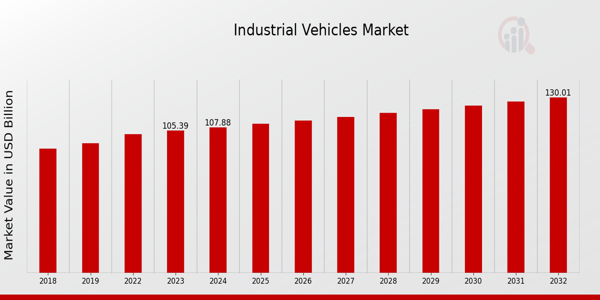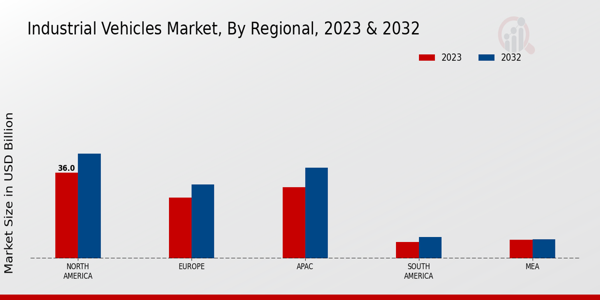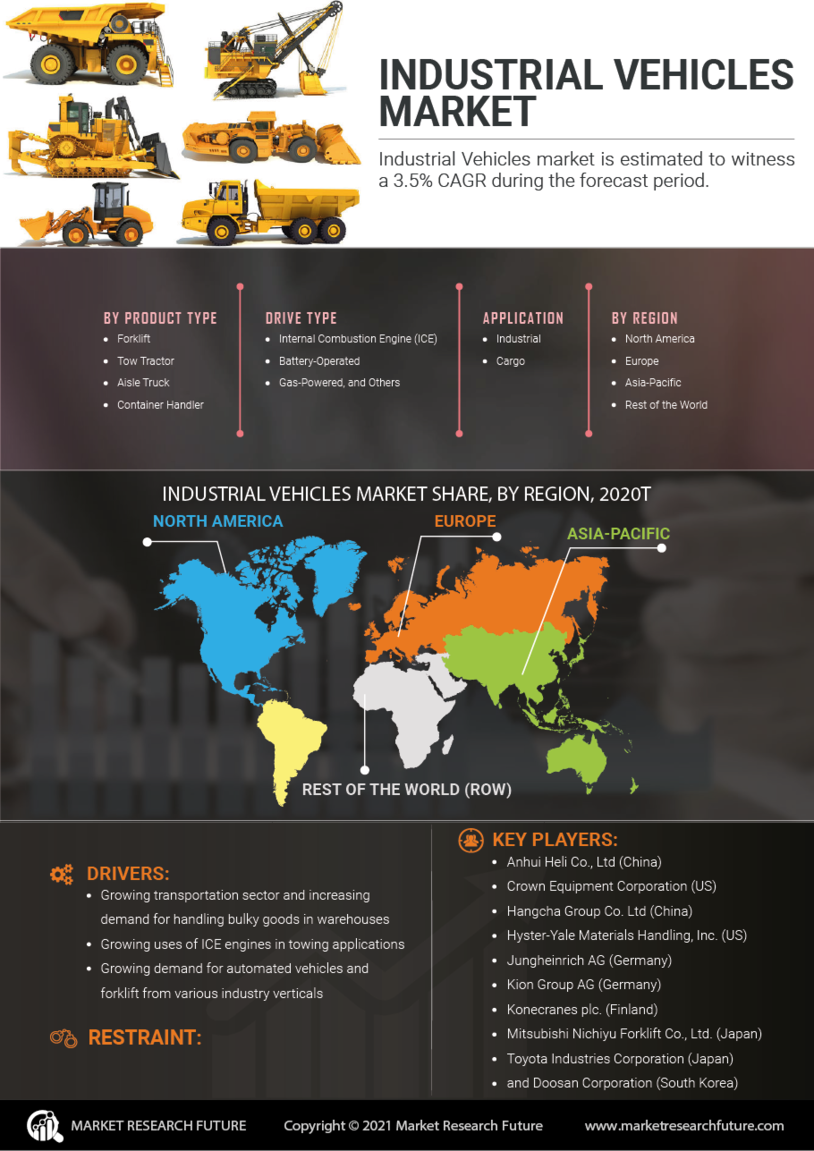Global Industrial Vehicles Market Overview:
As per MRFR analysis, the Industrial Vehicles Market Size was estimated at 102.96 (USD Billion) in 2022. The Industrial Vehicles Market Industry is expected to grow from 105.39 (USD Billion) in 2023 to 130.0 (USD Billion) by 2032. The Industrial Vehicles Market CAGR (growth rate) is expected to be around 2.36% during the forecast period (2024 - 2032).
Key Industrial Vehicles Market Trends Highlighted
The Industrial Vehicles Market is growing and is expected to continue expanding in the coming years. There is an increased demand for efficient handling solutions and vehicles like forklifts and pallet jacks across various sectors. Modern businesses aim to automate their factories and warehouses in order to cut down on costs, While e-commerce and logistics see a surge in demand. Furthermore, businesses are moving toward green goals. With electric vehicles and telematics in the market, operational efficiency has greatly improved.
Opportunities to be explored in this market abound, particularly as industries focus on integrating smart technologies into their operations. The demand for electric industrial vehicles is rising as businesses seek greener alternatives and aim to comply with stricter emissions regulations. Moreover, investments in infrastructure development worldwide provide a ripe opportunity for market players to introduce innovative products and solutions that can cater to the specific needs of various sectors, including construction, agriculture, and manufacturing. Companies that can effectively leverage advances in automation and data analytics will likely find themselves at a competitive advantage.
Trends in recent times indicate a shift towards electric and hybrid vehicles, driven by environmental concerns and government incentives promoting cleaner technologies. Enhanced safety features, such as automatic braking and collision detection systems, are becoming standard in modern industrial vehicles, reflecting the industry's commitment to worker safety and operational reliability. Additionally, the integration of Internet of Things (IoT) technologies is enabling better vehicle tracking and predictive maintenance, which enhances overall fleet management. These developments highlight the dynamic nature of the Industrial Vehicles Market and underscore the importance of innovation in meeting evolving customer needs.

Source: Primary Research, Secondary Research, Market Research Future Database and Analyst Review
Industrial Vehicles Market Drivers
Growing Demand for Automated Solutions
The rise in automation and the increasing demand for automated solutions are significant drivers for the Industrial Vehicles Market Industry. Industries are striving for greater efficiency and reduced operational costs, leading to a shift towards automated industrial vehicles. These vehicles are pivotal in warehouses, manufacturing plants, and distribution centers, where they facilitate tasks such as material handling, transportation, and logistics management.
The integration of advanced technologies, like IoT and AI, into industrial vehicles enhances their operational reliability, safety, and performance. As more companies recognize the benefits of implementing automated vehicles, their adoption is projected to increase significantly. This shift not only improves productivity but also satisfies the growing need for operational safety in industrial environments. Additionally, as technology becomes more accessible and affordable, small to medium enterprises are also looking to incorporate industrial vehicles into their operations, further fueling market growth.
The Industrial Vehicles Market Industry is likely to experience significant advancements due to innovations that drive the development of greener and more efficient vehicles. This aspect aligns well with the trend towards sustainability, where companies are expected to adopt eco-friendly practices. Thus, the emergent demand for automated solutions directly correlates with the expansion of the industrial vehicles market in the upcoming years.
Increase in E-commerce and Logistics Sector
The rapid growth of the e-commerce industry is a crucial driver for the Industrial Vehicles Market Industry. As online retail continues to flourish, the demand for efficient logistics and warehousing solutions has risen dramatically. This growth requires innovative industrial vehicles that can move goods swiftly and safely within warehouses and distribution centers. The necessity for quick turnaround times and accurate order fulfillment drives companies to invest in advanced industrial vehicles equipped with the latest technologies.
The increase in logistics and supply chain complexity demands vehicles that can handle diverse operational challenges, which propels the market forward.
Focus on Operational Efficiency
In a highly competitive environment, companies are constantly searching for ways to enhance operational efficiency. This focus on improving productivity and reducing costs plays a significant role in the growth of the Industrial Vehicles Market Industry. Industrial vehicles contribute to streamlined operations, allowing businesses to optimize resource management and minimize downtime. As companies emphasize efficiency in their operations, the demand for advanced industrial vehicles that facilitate these improvements continues to grow.
Manufacturers are responding to this need by introducing innovative vehicle designs and technologies that cater to the evolving requirements of various industrial sectors.
Industrial Vehicles Market Segment Insights:
Industrial Vehicles Market Type Insights
The Industrial Vehicles Market, valued at 105.39 USD Billion in 2023, showcases a diverse segmentation based on Type, bringing forth critical insights into various categories. Within this market, Forklifts emerge as the most dominant segment, with a significant valuation of 30.0 USD Billion in 2023, projected to increase to 37.0 USD Billion by 2032. Forklifts are essential in warehouses and manufacturing facilities, enabling efficient handling and movement of materials, thus holding a majority share in terms of revenue.
Following closely, the Tow Tractors segment stands strong with a valuation of 20.0 USD Billion in 2023, expected to grow to 25.0 USD Billion by 2032. Tow Tractors play a vital role in transporting goods and materials across short distances, serving industries like logistics and manufacturing, which contributes to their substantial market presence.
The Container Handling Trucks segment also holds significant value, clocking in at 25.0 USD Billion in 2023, with an anticipated rise to 30.0 USD Billion by 2032. This segment is crucial for maritime and port operations, managing the swift and efficient movement of shipping containers, hence playing a pivotal role in trade and supply chain efficiency.
Additionally, Industrial Tractors, valued at 15.0 USD Billion in 2023, are essential for various heavy-duty applications and are projected to reach 20.0 USD Billion by 2032. Their ability to handle considerable loads makes them indispensable in the construction and agricultural sectors. Meanwhile, Electric Vehicles have seen a rising trend within the market, valued at 15.39 USD Billion in 2023 and forecasted to be valued at 18.0 USD Billion by 2032. The emphasis on sustainability and reduced carbon emissions drives the demand for electric industrial vehicles, offering significant growth opportunities in an increasingly eco-conscious market.
The Industrial Vehicles Market segmentation reveals intricate interdependencies among these segments, with Forklifts leading in market share due to their versatile applications and essential functions in industrial operations. Overall, this market reflects a landscape driven by innovation, sustainability, and the need for operational efficiency, underpinned by the varied contributions of each segment to the industry's growth trajectory. The combination of heavy-duty capabilities and advances in electric technology shapes a promising future for the Industrial Vehicles Market.

Source: Primary Research, Secondary Research, Market Research Future Database and Analyst Review
Industrial Vehicles Market Fuel Type Insights
The Industrial Vehicles Market revenue is significantly influenced by the Fuel Type segment, which comprises various types, including Internal Combustion Engine, Electric, Hybrid, Compressed Natural Gas, and Liquid Propane Gas, showcasing the diverse operational needs of industries. In 2023, the market emphasized a shift towards more sustainable options, with electric vehicles gaining traction due to their lower environmental impact and operational efficiency, appealing to companies seeking eco-friendly solutions. Internal Combustion Engines still dominate the landscape due to their robustness and widespread availability, meeting the immediate demands of various industrial applications.
The Hybrid segment has also become significant, as many businesses look for versatile solutions that combine the advantages of both electric and combustion technologies. Compressed Natural Gas and Liquid Propane Gas serve as practical alternatives for industries seeking cost-effective and cleaner fuel options, further diversifying the Fuel Type offerings within the Industrial Vehicles Market statistics. This segmentation reflects the industry's need to balance performance, efficiency, and sustainability while navigating challenges such as regulatory pressures and evolving consumer preferences.
As industries adapt to contemporary trends, this segment continues to expand, opening opportunities for innovation and development.
Industrial Vehicles Market End-Use Insights
The Industrial Vehicles Market, valued at 105.39 USD Billion in 2023, showcases a diverse array of applications across various end-use sectors. Manufacturing and warehousing serve as significant drivers within the market, reflecting the need for efficient material handling and transportation solutions. Construction also plays a crucial role, with industrial vehicles being vital for site logistics and heavy lifting tasks, thereby enhancing project timelines. Agriculture has shown notable growth; the demand for specialized vehicles to aid in farming operations is rising due to increasing mechanization trends.
Retail has emerged as a key area, with industrial vehicles facilitating the transportation of goods in distribution centers and ensuring efficient inventory management. The interplay of these dynamics highlights the robust structure of the Industrial Vehicles Market, where the segmentation showcases a balanced distribution of capabilities across various industries, each contributing to overall market growth through unique operational requirements and efficiencies.
Industrial Vehicles Market Weight Category Insights
The Industrial Vehicles Market reached a valuation of 105.39 USD Billion in 2023, showcasing steady growth across various weight categories. The market segmentation into Light Duty, Medium Duty, Heavy Duty, and Ultra Heavy Duty highlights distinct applications and demand dynamics. Light-duty vehicles are often favored for their versatility in urban settings, while Medium-Duty vehicles serve intermediate tasks, bridging light and heavy applications. Heavy Duty vehicles dominate sectors like construction and logistics due to their high load capacities and robustness, maintaining a significant market presence.
Ultra heavy-duty vehicles, although a niche within the market, cater to specialized industries, offering unparalleled performance for extreme applications. The collective growth in these segments stems from rising industrial activities and infrastructure development, alongside increasing demand for efficient transportation solutions. However, challenges such as regulatory compliance and fluctuating fuel prices could impact market growth. Overall, trends such as automation and electrification are poised to create new opportunities, making the weight category a crucial focal point in the evolving landscape of the Industrial Vehicles Market.
Industrial Vehicles Market Regional Insights
The Industrial Vehicles Market is projected to witness significant revenue growth across various regions. In 2023, North America held the majority share, valued at 36.0 USD Billion, which is expected to rise to 44.0 USD Billion by 2032. This dominance reflects the region's robust industrial infrastructure and high demand for advanced vehicles. Europe follows closely with a market value of 25.5 USD Billion in 2023, increasing to 31.0 USD Billion, driven by stringent regulations and a focus on sustainability.
The APAC region, valued at 30.0 USD Billion in 2023 and anticipated to reach 38.0 USD Billion, reflects significant growth potential due to rapid industrialization and urbanization in countries like China and India.
In contrast, South America and MEA show lower valuations of 7.0 USD Billion and 7.89 USD Billion in 2023, respectively, with opportunities arising from infrastructure development projects. Overall, the Industrial Vehicles Market data reveals varied growth dynamics across these regions, influenced by economic activities, regulatory frameworks, and technological advancements, showcasing a diverse landscape with unique challenges and opportunities.

Source: Primary Research, Secondary Research, Market Research Future Database and Analyst Review
Industrial Vehicles Market Key Players and Competitive Insights:
The Industrial Vehicles Market is a dynamic and highly competitive landscape characterized by continuous advancements in technology, shifting consumer demands, and evolving operational efficiencies. This market encompasses a wide array of industrial vehicles, including forklifts, pallet trucks, and automated guided vehicles, all essential for optimizing material handling and logistics operations across various industries. Companies operating in this sector are increasingly focusing on innovation, sustainability, and cost-effective solutions to meet the diverse needs of their clients.
As globalization intensifies, the competitive forces within this market are not only influenced by traditional players but also by new entrants and disruptive technologies that are redefining the operational capabilities of industrial vehicles.
Toyota Material Handling holds a significant position in the Industrial Vehicles Market, known for its robust engineering and commitment to customer satisfaction. The company leverages its extensive R&D capabilities to introduce cutting-edge products that enhance efficiency and safety in material handling. Its strong market presence is supported by a diverse product line that caters to various industry needs, from small warehouses to large distribution centers. Toyota Material Handling's emphasis on ergonomics and sustainability resonates with modern businesses striving to create safer and more eco-friendly workplaces.
Furthermore, the company's network of dealers and service centers ensures that customers receive timely support and maintenance, further solidifying its reputation in the industry.
Kion Group is another major player in the Industrial Vehicles Market, recognized for its comprehensive range of industrial vehicles and related services. With a strong focus on innovation, Kion Group invests significantly in technology, particularly in automation and digital solutions, which drive efficiency and productivity in warehousing and logistics. The company's comprehensive product portfolio includes counterbalance forklifts, warehouse trucks, and software solutions that enhance supply chain operations. Kion Group has strategically positioned itself in emerging markets, capitalizing on growth opportunities by tailoring its offerings to local needs.
Additionally, its strong commitment to sustainability and corporate social responsibility initiatives aligns with the growing trend of environmentally conscious operations within the industrial sector. This multifaceted approach allows Kion Group to maintain a competitive edge while adapting to the ever-evolving demands of the market.
Key Companies in the Industrial Vehicles Market Include:
- Toyota Material Handling
- Kion Group
- Tadano
- HysterYale Materials Handling
- Mitsubishi Forklift
- Deere and Company
- Volvo
- Clark Material Handling Company
- JLG Industries
- Manitou Group
- Komatsu
- Doosan Bobcat
- CNH Industrial
- Caterpillar
- Hitachi Construction Machinery
Industrial Vehicles Market Industry Developments
The Industrial Vehicles Market is experiencing notable developments, with companies like Toyota Material Handling and Kion Group leading advancements in electric and autonomous vehicle technologies. The demand for sustainable solutions has prompted firms, including Hyster-Yale Materials Handling and Mitsubishi Forklift, to innovate their product lines to reduce carbon footprints. Recent reports indicate that Deere and Company are focusing on integrating AI in their vehicles to enhance operational efficiency.
In terms of mergers and acquisitions, Komatsu has successfully expanded its portfolio through the acquisition of a technology firm to bolster their automation capabilities, while CNH Industrial has also made strategic investments to enhance its market position.
Companies like Caterpillar and Hitachi Construction Machinery are investing heavily in research and development, aiming to enhance the robustness and performance of their industrial vehicles, which is driving growth in market valuation. This surge in market activity is significantly shaping the competitive landscape as these companies strive to meet the evolving needs of customers while addressing environmental concerns. Overall, the Industrial Vehicles Market is witnessing rapid evolution through technological innovation, strategic partnerships, and a growing focus on sustainability.
Industrial Vehicles Market Segmentation Insights
Industrial Vehicles Market Type Outlook
- Forklifts
- Tow Tractors
- Container Handling Trucks
- Industrial Tractors
- Electric Vehicles
Industrial Vehicles Market Fuel Type Outlook
- Internal Combustion Engine
- Electric
- Hybrid
- Compressed Natural Gas
- Liquid Propane Gas
Industrial Vehicles Market End-Use Outlook
- Manufacturing
- Warehousing
- Construction
- Agriculture
- Retail
Industrial Vehicles Market Weight Category Outlook
- Light Duty
- Medium Duty
- Heavy Duty
- Ultra Heavy Duty
Industrial Vehicles Market Regional Outlook
- North America
- Europe
- South America
- Asia-Pacific
- Middle East and Africa
|
Attribute/Metric
|
Details
|
|
Market Size 2022
|
102.96(USD Billion)
|
|
Market Size 2023
|
105.39(USD Billion)
|
|
Market Size 2032
|
130.0(USD Billion)
|
|
Compound Annual Growth Rate (CAGR)
|
2.36% (2024 - 2032)
|
|
Report Coverage
|
Revenue Forecast, Competitive Landscape, Growth Factors, and Trends
|
|
Base Year
|
2023
|
|
Market Forecast Period
|
2024 - 2032
|
|
Historical Data
|
2019 - 2022
|
|
Market Forecast Units
|
USD Billion
|
|
Key Companies Profiled
|
Toyota Material Handling, Kion Group, Tadano, HysterYale Materials Handling, Mitsubishi Forklift, Deere and Company, Volvo, Clark Material Handling Company, JLG Industries, Manitou Group, Komatsu, Doosan Bobcat, CNH Industrial, Caterpillar, Hitachi Construction Machinery
|
|
Segments Covered
|
Type, Fuel Type, End Use, Weight Category, Regional
|
|
Key Market Opportunities
|
Electric vehicle adoption, Automation in logistics, Equipment rental growth, Enhanced safety regulations, Smart technology integration
|
|
Key Market Dynamics
|
Growing automation in industries, Increased demand for material handling, Rising e-commerce and logistics needs, Strict environmental regulations, Technological advancements in vehicles
|
|
Countries Covered
|
North America, Europe, APAC, South America, MEA
|
Industrial Vehicles Market Highlights:
Frequently Asked Questions (FAQ):
The Industrial Vehicles Market is expected to be valued at 130.0 USD Billion in 2032.
The expected CAGR for the Industrial Vehicles Market from 2024 to 2032 is 2.36%.
The market size for Forklifts is expected to reach 37.0 USD Billion by 2032.
Container Handling Trucks were valued at 25.0 USD Billion in 2023 and are expected to reach 30.0 USD Billion in 2032.
Key players include Toyota Material Handling, Kion Group, Tadano, HysterYale Materials Handling, and more.
The expected market size for Electric Vehicles is forecasted to be 18.0 USD Billion by 2032.
The market value of Industrial Tractors is projected to reach 20.0 USD Billion by 2032.


















